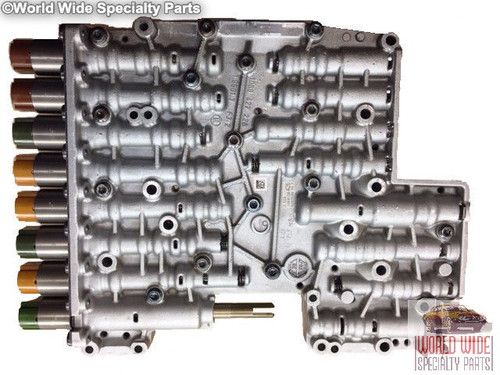The orange solenoid ZF 6HP generation 2 plays a crucial role in the functionality of automatic transmissions, specifically within the ZF 6HP series. These solenoids are essential for controlling fluid flow and pressure, which in turn controls gear shifts in the transmission.
In this article, we will dive deep into the details of the orange solenoid ZF 6HP generation 2, its importance, and how it fits within the broader valve body system. Additionally, we will explore how it compares to other solenoids used in the same system.
What is the ZF 6HP Transmission?
The ZF 6HP is a series of six-speed automatic transmissions developed by ZF Friedrichshafen AG, primarily used in high-performance vehicles. The system ensures smooth shifting and improved fuel efficiency, making it popular in various luxury and performance car brands. The orange solenoid ZF 6HP generation 2 is an integral part of this transmission, playing a vital role in optimizing its functionality.
Components of the Valve Body in ZF 6HP Generation 2:
The valve body is the control center for the hydraulic fluid that enables gear shifts. It contains various solenoids, each with specific functions and color coding. In a ZF 6HPxx GEN2 M-SHIFT valve body, the solenoids include:
- 2 blue solenoids
- 3 yellow solenoids
- 2 orange solenoids
- 1 green solenoid
The orange solenoid ZF 6HP generation 2 is responsible for controlling specific pressure channels essential for efficient gear shifting.
Function of the Orange Solenoid in ZF 6HP Generation 2:
The orange solenoid ZF 6HP generation 2 is known for its precision in managing hydraulic pressure. It controls the fluid flow to specific clutches or brake bands inside the transmission, ensuring smooth and timely gear shifts.

The valve body receives signals from the transmission control unit (TCU), and the orange solenoid ZF 6HP generation 2 responds by adjusting the pressure to allow for seamless shifting.
Importance of Solenoid Color Coding:
Color coding in solenoids is used to easily differentiate between their functions within the transmission system. The orange solenoid ZF 6HP generation 2 is specifically tuned for certain pressure applications. The difference between orange, blue, yellow, and green solenoids lies in the pressure thresholds they regulate.
Understanding the function of the orange solenoid ZF 6HP generation 2 is important for technicians working on repairs and upgrades, as replacing or recalibrating the wrong solenoid can lead to poor transmission performance or failure.
Orange Solenoid vs. Other Solenoids in ZF 6HP Generation 2:
While the orange solenoid ZF 6HP generation 2 focuses on certain pressure functions, the other solenoids handle different areas of the transmission system. For example:
- Blue solenoids: Control different pressure valves for clutch engagement.
- Yellow solenoids: Regulate shifting points for smooth transitions between gears.
- Green solenoid: Typically controls secondary fluid pressure regulation, aiding in overall system stability.
The orange solenoid ZF 6HP generation 2 is vital for its specific roles, but all solenoids must work together harmoniously to ensure optimal transmission performance.
Common Issues with the Orange Solenoid in ZF 6HP Generation 2:
Like any mechanical component, the orange solenoid ZF 6HP generation 2 can encounter issues over time. Some common problems include:
- Electrical Failures: If the wiring or connectors to the orange solenoid ZF 6HP generation 2 fail, the solenoid may not function correctly, leading to shifting problems.
- Clogged Solenoid: Contaminants in the transmission fluid can clog the orange solenoid ZF 6HP generation 2, restricting fluid flow and causing shifting delays.
- Worn Solenoid: Over time, the internal components of the orange solenoid ZF 6HP generation 2 can wear out, resulting in inconsistent pressure regulation and poor gear performance.
Diagnosing and Replacing the Orange Solenoid in ZF 6HP Generation 2:
Diagnosing an issue with the orange solenoid ZF 6HP generation 2 requires professional tools and expertise. Transmission specialists often use diagnostic tools to read fault codes from the transmission control unit (TCU). If the orange solenoid ZF 6HP generation 2 is found to be faulty, it can be replaced without needing to overhaul the entire transmission. Proper calibration and resetting the TCU are crucial to ensure that the new solenoid functions correctly.
The Role of the Orange Solenoid in Adaptive Transmission Systems:
The orange solenoid ZF 6HP generation 2 is a key component in adaptive transmission systems. These systems use sensors and solenoids to adjust the transmission’s behavior based on driving conditions and driver inputs.
The orange solenoid ZF 6HP generation 2 specifically assists in fine-tuning the hydraulic pressure that affects gear shifts, enabling the transmission to adapt to various driving styles. For example, under aggressive driving conditions, the orange solenoid ZF 6HP generation 2 can increase hydraulic pressure to ensure quicker and firmer shifts, enhancing vehicle performance.
Conversely, in normal driving conditions, it modulates pressure for smoother, more comfortable gear changes. This adaptability not only improves driving dynamics but also contributes to fuel efficiency by optimizing the transmission’s operation based on real-time conditions.
Impact of Transmission Fluid Quality on the Orange Solenoid:
The quality of the transmission fluid plays a significant role in the performance of the orange solenoid ZF 6HP generation 2. Transmission fluid acts as both a lubricant and a hydraulic medium, and any contamination or degradation can affect the solenoid’s operation. Dirty or degraded fluid can lead to clogging in the orange solenoid ZF 6HP generation 2, impairing its ability to regulate pressure accurately.

This can result in erratic shifting, increased wear on transmission components, and potential overheating. Regularly changing the transmission fluid and ensuring it meets the manufacturer’s specifications can help maintain the functionality of the orange solenoid ZF 6HP generation 2. Using high-quality fluid not only prolongs the life of the solenoid but also ensures smooth operation of the entire transmission system.
The Influence of Environmental Factors on the Orange Solenoid:
Environmental conditions can also affect the performance of the orange solenoid ZF 6HP generation 2. Extreme temperatures, both hot and cold, can impact the solenoid’s functionality. In cold climates, the transmission fluid can thicken, making it harder for the orange solenoid ZF 6HP generation 2 to regulate pressure accurately.
This can lead to sluggish shifting or delayed gear engagement. Conversely, in hot climates, high temperatures can cause the fluid to thin, potentially leading to increased wear and reduced pressure control accuracy.
Additionally, exposure to moisture and corrosive elements can lead to corrosion and damage to the solenoid. Ensuring the vehicle is properly maintained and operating in a climate-appropriate manner can help mitigate these issues and extend the life of the orange solenoid ZF 6HP generation 2.
Advances in Solenoid Technology and the Orange Solenoid:
Recent advances in solenoid technology have significantly improved the performance and reliability of components like the orange solenoid ZF 6HP generation 2. Modern solenoids incorporate advanced materials and manufacturing techniques that enhance their durability and responsiveness.
For instance, improvements in the design of the solenoid’s coil and valve mechanisms have led to more precise control of hydraulic pressure, resulting in smoother and more efficient gear shifts. Additionally, newer solenoids often feature better thermal management and resistance to contamination.
These advancements not only enhance the performance of the orange solenoid ZF 6HP generation 2 but also contribute to the overall reliability and longevity of the transmission system. Understanding these technological improvements can provide insights into the evolving nature of automotive components and their impact on vehicle performance.
Diagnostic Techniques for the Orange Solenoid ZF 6HP Generation 2:
Proper diagnosis of issues related to the orange solenoid ZF 6HP generation 2 is crucial for maintaining transmission health. Advanced diagnostic tools, such as electronic scan tools and pressure gauges, are commonly used to assess the performance of the solenoid.
These tools can read fault codes from the transmission control unit (TCU), which can indicate problems with the orange solenoid ZF 6HP generation 2 or other components in the system.
Additionally, technicians may perform pressure tests to ensure that the solenoid is regulating hydraulic pressure correctly. A well-maintained diagnostic approach helps in identifying issues early, allowing for timely repairs or replacements, which can prevent more significant transmission problems and ensure optimal vehicle performance.
The Impact of Aftermarket Parts on the Orange Solenoid ZF 6HP Generation 2:
Using aftermarket parts for the orange solenoid ZF 6HP generation 2 can have significant implications for transmission performance and durability. While aftermarket solenoids may offer cost savings, they often vary in quality and compatibility compared to OEM (Original Equipment Manufacturer) parts.

Inferior aftermarket solenoids may not meet the precise specifications required for the ZF 6HP generation 2 transmission, leading to issues such as erratic shifting, decreased efficiency, and potential damage to other transmission components.
When considering aftermarket options, it is essential to ensure they are compatible with the specific transmission model and meet or exceed OEM standards to avoid compromising the performance and reliability of the transmission system.
Maintenance Practices for Extending the Life of the Orange Solenoid:
Maintaining the orange solenoid ZF 6HP generation 2 involves several key practices to ensure its longevity and proper functioning. Regular transmission fluid changes are crucial, as they help keep the solenoid and other transmission components clean and free from contaminants.
Additionally, checking and maintaining proper fluid levels can prevent issues such as overheating and inadequate lubrication. Regular inspections of the transmission system, including the solenoid and its connections, can help identify and address any wear or damage before it becomes a more significant problem.
Implementing these maintenance practices can significantly extend the life of the orange solenoid ZF 6HP generation 2 and ensure reliable transmission performance.
The Evolution of Solenoid Technology in Transmission Systems:
The evolution of solenoid technology has led to significant advancements in transmission systems, including the orange solenoid ZF 6HP generation 2. Early solenoids were simpler devices with limited functionality, primarily controlling basic hydraulic functions.
Modern solenoids, however, incorporate sophisticated technologies such as electronic controls, improved materials, and advanced manufacturing techniques. These advancements have enhanced solenoid performance, providing more precise control over hydraulic pressure and contributing to smoother and more efficient gear shifts.
The development of variable solenoids, which can adjust their output based on real-time conditions, represents a major leap forward in transmission technology. Understanding these technological advancements provides insights into the continuous improvements in vehicle performance and the critical role of solenoids in modern transmissions.
Conclusion:
The orange solenoid ZF 6HP generation 2 is an essential component in ensuring smooth and efficient gear shifting in ZF 6HP automatic transmissions. Its specific role in controlling hydraulic pressure helps maintain the performance and longevity of the transmission. Understanding the orange solenoid ZF 6HP generation 2, alongside other solenoids like blue, yellow, and green, is important for anyone working on or owning vehicles equipped with this transmission. Proper maintenance and timely replacement of the orange solenoid ZF 6HP generation 2 can prevent many transmission issues and ensure optimal performance.


